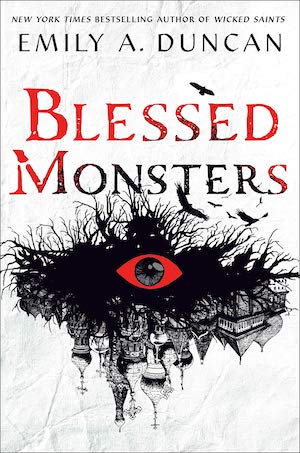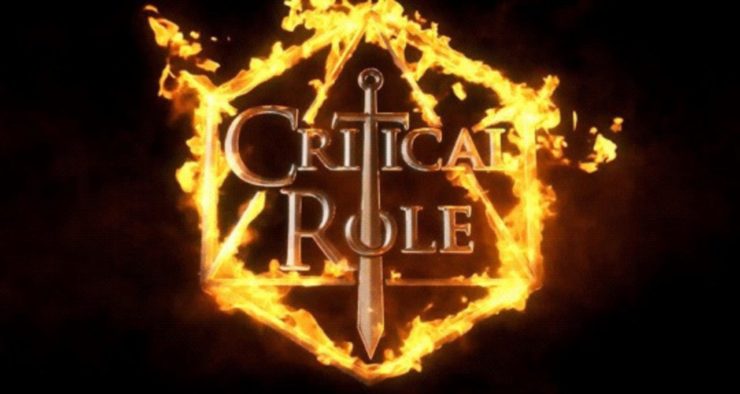So, you’ve listened to a few tabletop RPG podcasts (or none at all!) and have wanted to get into the ever growing in popularity Critical Role but you don’t know where to start and are kind of overwhelmed. It’s a daunting task, as Critical Role is currently some 240+ episodes and each episode is at least three hours long, sometimes stretching into five hours (those are usually boss battles and/or the most stressful episodes of all time). It makes for thousands of hours of content. It has spawned comic books, coffee table art books, merch, and an upcoming animated series.
Critical Role started in 2015, streamed on Geek and Sundry’s twitch channel (they have since moved to their own branded channel) and is made up of eight voice actors: Matthew Mercer, Marisha Ray, Travis Willingham, Sam Reigel, Liam O’Brien, Taliesin Jaffe, Ashley Johnson, and Laura Bailey. I first started watching it in 2015; I didn’t realize until writing this article that I’ve been a fan since literally the beginning. I was in grad school at the time, playing Dungeons and Dragons for the first time with a group of university librarians, and spending hours watching self-proclaimed nerdy-ass voice actors play Dungeons and Dragons.
Critical Role combines the fun of theater and high fantasy and that nice feeling of watching a group of people who are good friends have fun. It scratches a particular itch of meandering high fantasy that follows a party that all love each other but at the drop of a hat (or a failed wisdom saving throw) might betray each other at any minute. The world is deeply isolating right now, and there’s something comforting about turning on a podcast that’s engaging and hilarious but also just people having a great time and loving each other. The lore is detailed and expansive, and, for me, picks at the particular author side of my brain that loves to consider how high fantasy can be structured outside of just books. The show is, at its core, elaborate collaborative oral storytelling, which is part of why I think it’s grown so popular so fast. We humans have always loved oral storytelling, now we’ve just added some dice rolls into it to make it exciting.
But six years of content means it’s a little overwhelming on where to start and how to proceed! You don’t need to know all the mechanics of Dungeons and Dragons to watch the show. In essence, the game is pretty intuitive and you’ll pick up on the rules of it relatively quickly while listening, even if you’ve never played yourself. Again, at the end of the day it’s all just storytelling! Take my hand, I will tell you what I love about both campaigns and you can use this knowledge to decide on where to start.
Season One: Vox Machina
115 episodes
I will be honest, Vox Machina has my whole heart and not just because the character Vax is the exact kind of melodramatic yet silly goth boy that I gravitate toward in all of my favorite media. The show starts about three years into the group’s campaign, so it’s a little in media res and takes a bit to get situated. Season one follows a motley team of chaotic adventurers on their journey through the lands of Tal’dorei and Exandria. The cast is:
- Half-elf rogue and ranger twins, Vax’ildan (rogue) and Vex’ahlia (ranger), played by Liam O’Brien and Laura Bailey.
- Goliath barbarian, Grog Strongjaw, played by Travis Willingham.
- Human gunslinger, Percival de Rolo (Lord Percival Fredrickstein von Musel Klossowski de Rolo III), played by Taliesin Jaffe.
- Half-elf druid, Keyleth, played by Marisha Ray.
- Gnome bard, Scanlan Shorthalt, played by Sam Riegel.
- Gnome paladin, Pike Trickfoot, played by Ashley Johnson.
- Dungeon Master but, also Trinket the bear, played by Matthew Mercer. Extremely important.
- Other player characters include Taryon Darrington, a human artificer played by Sam Reigel who shows up mid-campaign, and Tiberius Stormwind, a dragonborn sorcerer played by Orion Abaca who departs in chapter three.
Generally, my advice is to start at the beginning with Vox Machina simply because you know how many episodes you’re committing to ahead of time. The audio quality on the first twenty or so episodes is a little rough, and there’s some expected awkwardness as the group takes something that had been personal and private into the public eye. When they first start roleplaying romance it is so charmingly awkward for everyone at the table.
A popular consensus, and one I recommend, is starting at episode 24, which is the beginning of the Briarwood arc when the group ends up in a revenge quest for Percy, taking on a vampire power couple who murdered his family. Starting here skips over the first two arcs, The Mines of Kraghammer and the Adventures in Vasselheim (also called the Trial of the Take), but everyone at the table is more comfortable and the energy of the group is more vibrant after the removal of a player who caused some tension within the first two arcs. Because the campaign already drops you randomly at the beginning of a quest point, it’s easy to just start a little later on and pick up quickly enough on what has happened previously.
The Vox Machina campaign goes from high energy intensity to wildly silly antics as the group deals with dragons, a revenge quest, magic trials, deals made with gods, to the entire party being turned into cows. It’s the kind of campaign that you think of when you think of Dungeons and Dragons, that specific flavor of high fantasy drama that, if you were a kid like me who didn’t have any way to actually play Dungeons and Dragons, you found within the pages of Dragonlance or Forgotten Realms books. The interpersonal relationships between the cast members start out strong and only become stronger, and it’s one of the reasons I really encourage people to simply start at the beginning.
The Vox Machina campaign also has two volumes of comic books that goes into the events that happened before the start of the stream, and there’s a future animated series in the works, so if you do decide to start with season two, know that there are other ways to meet the utterly charming cast of the first campaign.
Season Two: The Mighty Nein
125 episodes (as of February 26th, 2021, ongoing)
The second campaign somehow has a radically different flavor to the first, while still being just as charming and chaotic. It follows a group of characters that start out on the neutral side of the alignment scale, and the vibe is less “saving the kingdom” than “oh no we keep falling face first into dramatic events.” Part of this is because we see this group from the very start of their journey in a way we didn’t with Vox Machina. It starts about twenty years after Vox Machina in the timeline (and we do meet some familiar NPCs from the first season). It takes place in a different setting, on the continent of Wildemount. In season two the cast is:
- Human monk, Beauregard “Beau” Lionett, played by Marisha Ray.
- Human wizard, Caleb Widogast, played by Liam O’Brien.
- Half-orc warlock, Fjord, played by Travis Willingham.
- Tiefling cleric, Jester Lavorre, played by Laura Bailey.
- Tiefling blood hunter Mollymauk “Molly” Tealeaf and Firbolg cleric, Caduceus Clay, played by Taliesin Jaffe.
- Goblin rogue, Nott the Brave, played by Sam Riegel.
- Aasimar barbarian, Yasha Nydoorin, played by Ashley Johnson.
- And, of course, the Dungeon Master, Matthew Mercer.
Season two has player character deaths (that have been handled in a truly incredible and compelling way. The storytelling around said character has been masterful and a delight to witness), more than one evil purple boy (one of them does do a war crime and I do love him), a city of Drow elves, a seafaring arc, so many fascinating interactions with the divine pantheon, and five kobolds in a trench coat. Something I really love in campaign two is that the setting moves into cities that are full of goblins and kobolds and bugbears, creatures that are typically expendable enemy fodder in a Dungeons and Dragons campaign, but brings them into dramatic (and oftentimes hilarious) life and ignores the problematic Dungeons and Dragons concept of “evil races.” There’s a different kind of tension in campaign two than in campaign one, as countries are at the brink of all out war and the party is forced to make tense political maneuvers (at times accidentally) to keep the worst from happening. It has less of a point A to point B feel and more of a wide expanse of story arcs that are all being woven together. The party is carrying a lot of trauma and watching them slowly work through it and start to heal is wonderfully rewarding.
***
Whether you start at season one or season two, what you’ll find is a lot of antics, a lot of heartfelt dives into trauma and what makes a family, and a lot of high fantasy nonsense. It has brought me a lot of joy in the past six years, and I’m excited to see where it all goes next.
Originally published March 2021.
Buy the Book


Blessed Monsters
Emily A. Duncan is the New York Times bestselling author of Wicked Saints, Ruthless Gods, and Blessed Monsters. They work as a youth services librarian and received a Master’s degree in library science from Kent State University, which mostly taught them how to find obscure Slavic folklore texts through interlibrary loan systems. When not reading or writing, they enjoy playing copious amounts of video games and dungeons and dragons. They live in Ohio.










